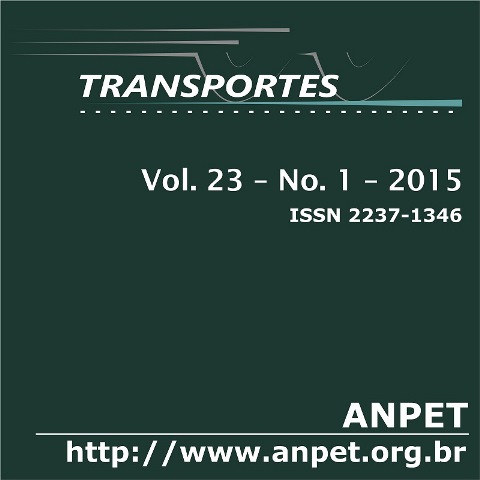Tomada colaborativa de decisão com utilização de teoria dos jogos para o sequenciamento de decolagens em aeroportos
DOI:
https://doi.org/10.14295/transportes.v23i1.828Keywords:
airport, air traffic management, game theory, collaborative decision making.Abstract
Currently in Brazil the decisions in aircraft departure management depend exclusively on the controller’s expertise, which empirically decides the departure sequence scheduling. This work describes the implementation of a Collaborative Departure Management system in airports (CoDMAN) through the concept of Collaborative Decision Making (CDM) with the application of Game Theory. In this model, each agent represents an aircraft that impacts the airport scenario and their decisions are based on the negotiation in dynamic multiagent scenarios in order to yield efficient departure sequences. A prototype was developed with the simulations using flight plans valid to the International Airport of Brasília. The interface with radar systems was also simulated through the evaluation of the impacting flights in TMA-Brasilia during in February 2013 with satisfactory results. The departure sequencing optimization reduced the cost associated to the delays up to 28%, which demonstrates the efficacy of the developed model.Downloads
References
A. M. F. Crespo. Módulo de avaliação e apoio à decisão: uma aplicação de aprendizagem por reforço no gerenciamento tático do fluxo de tráfego aéreo. Master’s thesis, University of Brasília – Science of Computation Department, 2010.
M. Groppe, R. Paglieri, and D. Harris. Field observations during Airport-CDM turn-round process: Study on airline’s approach to TOBT assignment. EUROCONTROL Experimental Centre, 2010.
Comando da Aeronáutica. Demanda Detalhada dos Aeroportos Brasileiros, volume 1. Brazilian Institute of Civil Aviation, 2005.
M. Yildiz. Nash meets Rubinstein in final-offer arbitration. Massachusetts Institute of Technology, Economics Department, November 2010. DOI: 10.1016/j.econlet.2010.10.020
A. C. Arruda Jr. Aprendizagem por reforço aplicada à análise de impacto no controle de fluxo de tráfego aéreo. Master’s thesis, University of Brasília – Science of Computation Department, 2009.
C. A. Holt and A. E. Roth. The Nash equilibrium: A perspective. Proceedings of the National Academy of Sciences of the United States, 101(12): 3999 – 4002, 2004. DOI: 10.1073/pnas.
L. Weigang, B.B. Souza, A.M.F. Crespo, and D.P. Alves. Deci-sion support system in tactical air traffic flow management for air traffic flow controllers. Journal of Air Transport Management, 14(6):329 – 336, 2008.
International Civil Aviation Organization. Manual on Simultane-ous Operations on Parallel or Near-Parallel Instrument Runways (SOIR). International Civil Aviation Organization, 1 edition, 2004.
D. Bertsimas and S. Gupta. Fairness in air traffic flow manage-ment. INFORMS Meeting, San Diego - CA, USA, 2009.
V. F. Ribeiro. Decisão colaborativa com utilização de Teoria dos Jogos para o sequenciamento de partidas em aeroportos. Mas-ter’s thesis, University of Brasília – Science of Computation Department, 2013.
EUROCONTROL. Airport CDM Implementation - The Manual for Collaborative Decision Making. Eurocontrol, 2010.
T. L. Turocy and B. von Stengel. Game Theory. Number 5. Computational, Discrete and Applicable Mathematics, 2001. CDAM Research Report LSECDAM-2001-09.
A. L. Manocchio. Teoria dos jogos e negociação. Undergraduate thesis, Mathematics Applied to Business Course, University of São Paulo, 2007.
T. Vossen, M. Ball. Optimization and mediated bartering models for ground delay programs. Naval Research Logistics 53 (1), 75–90, 2006. DOI: 10.1002/nav.20123
M. Ball, R. Hoffman, D. Knorr, J. Wetherly, and M. Wambsganss. Assessing the benefits of collaborative decision making in air traffic flow management. 3rd USA/Europe Air Traffic Management Research and Development Seminar, April 2000.
DECEA. Implementação Operacional do Conceito de Navegação Baseada em Performance (PBN) no Espaço Aéreo Brasileiro. Circular de Informação Aeronáutica 24/13. 12/12/2013.
R. Goldman. A-CDM in New York KJFK Runway Construction and Impact on Operations. In Advanced ATM Techniques Sym-posium and Workshops, 4 – 6 November 2013, ICAO Headquar-ters, Montréal.
N. J. Ashford, S. Mumayiz and P. H. Wright. Airport Engineer-ing: Planning, Design and Development of 21st Century Airports. 4th edition, John Wiley & Sons, 2011. DOI: 10.1002/9780470950074
Downloads
Published
How to Cite
Issue
Section
License
Authors who submit papers for publication by TRANSPORTES agree to the following terms:
- The authors retain the copyright and grant Transportes the right of first publication of the manuscript, without any financial charge, and waive any other remuneration for its publication by ANPET.
- Upon publication by Transportes, the manuscript is automatically licensed under the Creative Commons License CC BY 4.0 license. This license permits the work to be shared with proper attribution to the authors and its original publication in this journal.
- Authors are authorized to enter into additional separate contracts for the non-exclusive distribution of the version of the manuscript published in this journal (e.g., publishing in an institutional repository or as a book chapter), with recognition of the initial publication in this journal, provided that such a contract does not imply an endorsement of the content of the manuscript or the new medium by ANPET.
- Authors are permitted and encouraged to publish and distribute their work online (e.g., in institutional repositories or on their personal websites) after the editorial process is complete. As Transportes provides open access to all published issues, authors are encouraged to use links to the DOI of their article in these cases.
- Authors guarantee that they have obtained the necessary authorization from their employers for the transfer of rights under this agreement, if these employers hold any copyright over the manuscript. Additionally, authors assume all responsibility for any copyright infringements by these employers, releasing ANPET and Transportes from any responsibility in this regard.
- Authors assume full responsibility for the content of the manuscript, including the necessary and appropriate authorizations for the disclosure of collected data and obtained results, releasing ANPET and Transportes from any responsibility in this regard.









